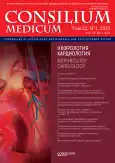Biomarkers of acute kidney disease. Potential application in practice
- Authors: Schelkanovtseva E.S.1,2, Mironova O.I.1, Fomin V.V.1
-
Affiliations:
- Sechenov First Moscow State Medical University (Sechenov University)
- City Polyclinic №67
- Issue: Vol 23, No 1 (2021)
- Pages: 15-19
- Section: Articles
- URL: https://journals.rcsi.science/2075-1753/article/view/95380
- DOI: https://doi.org/10.26442/20751753.2021.1.200729
- ID: 95380
Cite item
Full Text
Abstract
Keywords
Full Text
##article.viewOnOriginalSite##About the authors
Ekaterina S. Schelkanovtseva
Sechenov First Moscow State Medical University (Sechenov University); City Polyclinic №67
Email: mar-shhelkanovceva@yandex.ru
ординатор каф. факультетской терапии Moscow, Russia
Olga Iu. Mironova
Sechenov First Moscow State Medical University (Sechenov University)канд. мед. наук, доц. каф. факультетской терапии Moscow, Russia
Viktor V. Fomin
Sechenov First Moscow State Medical University (Sechenov University)чл.-кор. РАН, д-р мед. наук, проф., проректор по клинической работе и дополнительному профессиональному образованию, зав. каф. факультетской терапии Moscow, Russia
References
- Srisawat N, Kellum JA. The Role of Biomarkers in Acute Kidney Injury. Crit Care Clin 2020; 36 (1): 125-40. doi: 10.1016/j.ccc.2019.08.010
- Bihorac A, Chawla LS, Shaw AD, et al. Validation of Cell-Cycle Arrest Biomarkers for Acute Kidney Injury Using Clinical Adjudication. Am J Respir Crit Care Med 2014; 189 (8): 932-9. doi: 10.1164/rccm.201401-0077OC
- Ostermann M, Zarbock A, Goldstein S, et al. Recommendations on Acute Kidney Injury Biomarkers From the Acute Disease Quality Initiative Consensus Conference. A Consensus Statement. JAMA Netw Open 2020; 3 (10): e2019209. doi: 10.1001/jamanetworkopen.2020.19209
- Guzzi LM, Bergler T, Binnall B, et al. Clinical use of TIMP-2/IGFBP7 biomarker testing to assess risk of acute kidney injury in critical care: guidance from an expert panel. Crit Care 2019; 23 (1): 225. doi: 10.1186/s13054-019-2504-8
- Kellum JA, Lameire N, Aspelin P, et al. Kidney Disease: Improving Global Outcomes (KDIGO) Clinical Practice Guideline for Acute Kidney Injury. Kidney Int Sppl 2012; 2 (1): 1-138. doi: 10.1038/kisup.2012.1
- Adler C, Heller T, Schregel F, et al. TIMP-2/IGFBP7 predicts acute kidney injury in out-of-hospital cardiac arrest survivors. Crit Care 2018; 22 (126): 1-8. doi: 10.1186/s13054-018-2042-9
- Noto A, Cortegi ani A, David A. NephroCheck: should we consider urine osmolality? Crit Care 2019;(1): 48. doi: 10.1186/s13054-019-2341-9
- Di Somma S, Magrini L, De Berardinis B, et al. Additive value of blood neutrophil gelatinaseassociated lipocalin to clinical judgement in acute kidney injury diagnosis and mortality prediction in patients hospitalized from the emergency department. Crit Care 2013; 17 (1): R29. doi: 10.1186/cc12510
- Elyasi S, Khalili H, Dashti-Khavidaki S, Mohammadpour A. Vancomycin-induced nephrotoxicity: mechanism, incidence, risk factors and special populations. A literature review. Eur J Clin Pharmacol 2012; 68 (9): 1243-55. doi: 10.1007/s00228-012-1259-9
- Hoste E, Bihorac A, Al-Khafaji A, et al. Identification and validation of biomarkers of persistent acute kidney injury: the RUBY study. Intensive Care Med 2020; 46: 943-53. doi: 10.1007/s00134-019-05919-0
- Gaede L, Liebetrau C, Blumenstein J, et al. Plasma microRNA-21 for the early prediction of acute kidney injury in patients undergoing major cardiac surgery. Nephrol Dial Transplant 2016; 31 (5): 760-6. doi: 10.1093/ndt/gfw007
- Shah KS, Taub P, Patel M, et al. Proenkephalin predicts acute kidney injury in cardiac surgery patients. Clin Nephrol 2015; 83 (1): 29-35. doi: 10.5414/CN108387
- Cruz DN, Ricci Z, Ronco C. Clinical review: RIFLE and AKIN - time for reappraisal. Crit Care 2009;(3): 211. doi: 10.1186/cc7759
- Oh DJ. A long journey for acute kidney injury biomarkers. Ren Fail 2020; 42 (1): 154-65. doi: 10.1080/0886022X.2020.1721300
- Dasta JF, Kane-Gill SL, Durtschi AJ, et al. Costs and outcomes of acute kidney injury (AKI) following cardiac surgery. Nephrol Dial Transplant 2008; 23 (6): 1970-4. doi: 10.1093/ndt/gfm908
- Alshaikh HN, Katz NM, Gani F, et al. Financial impact of acute kidney injury after cardiac operations in the United States. Ann Thorac Surg 2018; 105 (2): 469-75. doi: 10.1016/j.athoracsur.2017.10.053
- Магзумова Г.Е., Гайпов А.Э., Толеп К.О., и др. Липокалин, ассоциированный с желатиназой нейтрофилов (NGAL) - ранний маркер острого повреждения почек. Клин. медицина Казахстана. 2014: 104-5 [Magzumova G.E., Gaipov A.E., Tolep K.O., et al. Lipokalin, assotsiirovannyi s zhelatinazoi neitrofilov (NGAL) - rannii marker ostrogo povrezhdeniia pochek. Klin. meditsina Ka-zakhstana. 2014: 104-5 (in Russian)].
Supplementary files






